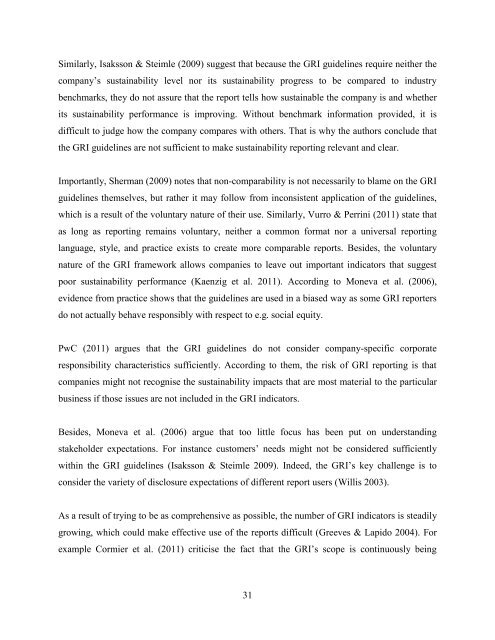Developing sustainability reporting - Case Cargotec - Aaltodoc
Developing sustainability reporting - Case Cargotec - Aaltodoc
Developing sustainability reporting - Case Cargotec - Aaltodoc
Create successful ePaper yourself
Turn your PDF publications into a flip-book with our unique Google optimized e-Paper software.
Similarly, Isaksson & Steimle (2009) suggest that because the GRI guidelines require neither the<br />
company’s <strong>sustainability</strong> level nor its <strong>sustainability</strong> progress to be compared to industry<br />
benchmarks, they do not assure that the report tells how sustainable the company is and whether<br />
its <strong>sustainability</strong> performance is improving. Without benchmark information provided, it is<br />
difficult to judge how the company compares with others. That is why the authors conclude that<br />
the GRI guidelines are not sufficient to make <strong>sustainability</strong> <strong>reporting</strong> relevant and clear.<br />
Importantly, Sherman (2009) notes that non-comparability is not necessarily to blame on the GRI<br />
guidelines themselves, but rather it may follow from inconsistent application of the guidelines,<br />
which is a result of the voluntary nature of their use. Similarly, Vurro & Perrini (2011) state that<br />
as long as <strong>reporting</strong> remains voluntary, neither a common format nor a universal <strong>reporting</strong><br />
language, style, and practice exists to create more comparable reports. Besides, the voluntary<br />
nature of the GRI framework allows companies to leave out important indicators that suggest<br />
poor <strong>sustainability</strong> performance (Kaenzig et al. 2011). According to Moneva et al. (2006),<br />
evidence from practice shows that the guidelines are used in a biased way as some GRI reporters<br />
do not actually behave responsibly with respect to e.g. social equity.<br />
PwC (2011) argues that the GRI guidelines do not consider company-specific corporate<br />
responsibility characteristics sufficiently. According to them, the risk of GRI <strong>reporting</strong> is that<br />
companies might not recognise the <strong>sustainability</strong> impacts that are most material to the particular<br />
business if those issues are not included in the GRI indicators.<br />
Besides, Moneva et al. (2006) argue that too little focus has been put on understanding<br />
stakeholder expectations. For instance customers’ needs might not be considered sufficiently<br />
within the GRI guidelines (Isaksson & Steimle 2009). Indeed, the GRI’s key challenge is to<br />
consider the variety of disclosure expectations of different report users (Willis 2003).<br />
As a result of trying to be as comprehensive as possible, the number of GRI indicators is steadily<br />
growing, which could make effective use of the reports difficult (Greeves & Lapido 2004). For<br />
example Cormier et al. (2011) criticise the fact that the GRI’s scope is continuously being<br />
31
















